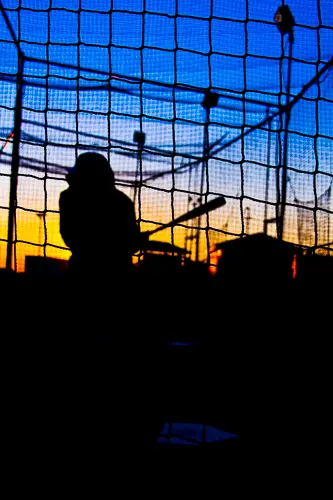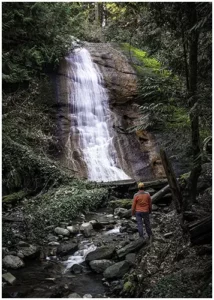
Harness the Power of Light and Shadow in Landscape Photography
In photography, light and shadow are essential for creating captivating photos. It’s important to grasp


Silhouette photography has always fascinated me. It’s a captivating technique that can add magic and intrigue to your photos. Plus it’s an easy technique to master.
If you’re a new photographer or just looking to unleash your creativity and create images that capture your viewers’ attention. Then silhouette photography is the perfect technique to try. With silhouettes, you’ll experiment with different light sources, play with shadows and shapes, and use your composition skills to tell stories. With just a bit of practice, you’ll be able to create striking and captivating photos. So why not step out of your comfort zone and try creating some silhouette photos today? Who knows what kind of magic you’ll create with your camera!
Whether you’re a pro or newbie, our guide will help you advance your silhouette photography skills. Join me in exploring the captivating world of Silhouette in photography! Dive in and discover the art of Silhouette photography!
A silhouette photograph is normally a dark shape or outline of a subject against a lighter background. It’s done by placing the subject in front of a strong light source, like a sunset or sunrise, and exposing for the background instead of the subject.
Silhouette photography can convey drama, emotion, and mood, all the while minimizing details. Silhouettes can range from small objects to people, trees, bridges, and buildings.
As mentioned, silhouette photography is a technique that captures the subject as a dark shape against a bright background. Unlike regular photographs, silhouettes rely on recognizable shapes rather than details and colours. To create stunning silhouette images, start by choosing a subject with a strong and recognizable shape, such as a person, animal, or object. Look for a bright light source, and position your subject between the light and the camera.
I prefer to capture silhouettes during the golden hour, which is the first or last hour of daylight when the light is soft and warm. However, you can also create silhouettes at other times of the day by using a strong light source. To improve your silhouette photos, use leading lines and the rule of thirds to create a balanced composition. Adding negative space can also create a more dramatic and mysterious mood. In post-processing, you can boost the contrast, add saturation, and adjust the shadows and highlights to perfect your silhouette. With these tips and techniques, you can create stunning silhouette images that stand out from the crowd.
Using a tripod when shooting silhouettes can make all the difference in capturing a clear and tack sharp image. As silhouettes often require longer exposure times, a tripod can help stabilize your camera and prevent blurry shots. Plus, it allows you to experiment with different angles and compositions without worrying about camera shake. Investing in a quality tripod, you’ll be able to create stunning and professional-looking silhouettes that showcase your creative vision and leave your audience in awe.
Using a remote, or setting the camera timer, will also help you avoid any unnecessary movement when pressing the shutter.
Setting your camera to manual mode is crucial when shooting a silhouette in photography. This allows you to manually set your exposure, focus, and other settings, giving you more control over the final image.
To set your camera to manual mode for shooting a silhouette, follow these steps:
When shooting a silhouette, it’s important to expose for the background, not the subject. I often use the recomposing trick. This is where you set the proper camera exposure for the background, then reset the framing for the camera.
This should be obvious. Don’t use flash when shooting silhouettes!
Also try Exposure Bracketing, shooting a series of shots with varied exposures and picking the best one. If your subject is still not dark enough, use exposure compensation.
Make sure to check the exposure of your shot by analyzing your camera’s histogram. Highlights shouldn’t be overexposed; check that the shadows are not underexposed. In a proper silhouette, the histogram should lean towards the left. Remember that most of the image’s is in the shadow area.

When planning your silhouette, remember the subject plays a crucial role in creating a striking and captivating photo. The best subjects are those having a distinctive shape or outline, people, trees, or buildings. Choose a subject that is a recognizable silhouette that adds depth and interest to your photo.
When you’re looking for the perfect subject, keep in mind the shapes and lines that will make your image stand out and captivate your audience.
When taking a silhouette photo, it’s crucial to compose the shot to avoid a cluttered background. Select an appealing space that will enhance the silhouette. When shooting in a city, change the perspective by photographing down low and looking up against the sky. Eliminate objects in the background that distract from the subject, such as electricity lines. Finally, make sure that the subject has a distinct outline that doesn’t blend in with the background.
Silhouette photography is a fun and creative way to capture memories. Experiment with different angles and positions, try shooting from a low angle to capture more of the background. Changing the angle and position of the light source can also create contrast and mood in your images. Use bracketing techniques to capture all the details of a sunset silhouette, or try partial silhouettes for a multidimensional effect. Don’t limit yourself to just human subjects – try capturing your gear or other objects as well. For a creative spin, include rim light to highlight the edges of your subject. Remember to pose your subject in the brightest part of the frame and bump up the shadows for effect. With these tips, you’ll be creating unique and striking silhouettes in no time!

Position the subject in front of the light source, ensuring that the subject’s outline is distinct and eye-catching. Adjust camera settings such as exposure and focus to optimize the background lighting to create the desired effect. To be more creative with silhouettes, try incorporating props or capturing the subject in action. With these tips, you can create captivating silhouettes that will enhance your photo portfolio.
Silhouette portraits are a fantastic way to add drama and emotion to otherwise hum-drum photos. To take a silhouette photo, place your subject in front of a strong light source like a bright window, or doorway. Darken the image to create a clear contrast between the subject and the background. When it comes to camera settings, a low ISO and a wide aperture will give you the best results, while a fast shutter speed can help you freeze any movement in your subject. A wide-angle lens captures more of the background. A telephoto lens isolates the subject for a dramatic effect. With these tips and some practice, you’ll be able to create stunning silhouette portraits that capture the beauty and emotion of your subject.
To capture a stunning silhouette, it’s crucial to have optimal lighting conditions. I prefer shooting during sunrise or sunset when the sun is low on the horizon. Create silhouettes using artificial light by placing the light source behind your subject. The key is to have a light behind the subject.
Indoors, you can use natural light by taking your photograph against a window or artificial light. Vary your images by shooting in doorways or changing position to create a sunburst effect or rim light. Placing your subject in the brightest part of the frame maximizes contrast and draws attention. The level of brightness depends on the time of day and the mood you want to set with the image.
For a perfect silhouette, keep the foreground lighting to an absolute minimum, as dark as possible.
Don’t miss out on the opportunity to capture awe-inspiring images. When selecting a subject for a silhouette, choose something with a clear and recognizable shape that will capture the viewer’s imagination.
Using a low ISO setting is crucial when capturing silhouette in photography. By using a low ISO you effectively reduce unwanted noise or grain from your photo. As the sun sets and the light decreases, it may be tempting to increase the ISO to brighten the image. However, doing so can result in unwanted noise, which is especially noticeable in the black areas of the image. To avoid this, I recommended keeping the ISO as low as possible and adjust the shutter speed and aperture accordingly. This will ensure that the final image has a clean and sharp silhouette without any distracting noise.
Use a high aperture f/8 or above. This will increase your depth of field and keep all elements in focus. It also allows you to create a starburst effect from the sun. Additionally, having a wide-angle lens and shooting from a distance can also ensure that both your subject and background are sharp.
To achieve a perfect silhouette shot, you need to position your subject in front of the light source. This will cause your subject to be completely backlit, resulting in a dark silhouette of their body. To do this, find the scene’s main light source and ensure that it shines from the back of the subject, not the front. You don’t need the light to come from directly behind the subject, but the brighter the background, the better. Remember, the goal is to keep the background bright and the subject dark.
I highly recommend using your camera spot metering mode, and then recomposing. Spot metering mode allows you to take precise measurements of the light of the background. Which is essential for creating a well-defined silhouette. By setting your camera to spot metering, you ensure the camera only measures the exposure where you’re pointing the camera.
This helps you to achieve a more accurate and consistent exposure, and allows you to capture the full impact of your subject’s outline and shape. So don’t miss out on the benefits of spot metering mode, it’s an essential tool for any aspiring silhouette photographer!
To make your silhouette photos stand out, look for unique and intriguing scenes that add interest and depth to your photos. Experimenting with different subjects, such as animals, objects, or people in motion, to create dynamic silhouettes. Don’t be afraid to get creative and think outside of the box. By choosing distinctive and interesting subjects, you’ll be able to capture images that truly stand out and leave a lasting impression on your audience.
One of the most exciting aspects of creating silhouettes is the ability to capture movement in a dynamic and visually interesting way. You can control motion in your photos by adjusting the shutter speed and exposure settings. This allows you to either freeze the subject or create a blurry effect that adds a dynamic feel to your pictures.
When you photograph a dancer or a runner, their movement can give your pictures an amazing energy that will impress your audience. So why not try experimenting with movement in your next silhouette photo shoot and see where your creativity takes you!
Clouds can add depth, drama, and a sense of awe to your silhouette photography. Adding unique cloud formations to your photos, such as fluffy white clouds, dark storm clouds, or a dramatic sunset sky, can elevate them to another level. Clouds can also help balance the composition of your image, add a touch of colour, and create a striking contrast against your dark silhouette. So next time you’re out shooting, don’t forget to look up and take advantage of the amazing natural canvas that is the sky!
In terms of shooting stunning silhouettes in photography, there are a few essential pieces of equipment that you’ll need. Firstly, you’ll need a camera that allows you to manually adjust the exposure settings. While a DSLR or mirrorless camera is ideal, even a smartphone can work if you use apps that specialize in silhouette photography. You’ll want to use a lens with a relatively high aperture, such as f/8 or higher, to widen your depth of field and keep everything in focus.
I would suggest a tripod to avoid blurriness or camera shake, and to allow you to be a part of the subject. For better photos, use ISO 100 to reduce image noise and set your aperture between f/8 and f/11 to keep your subject in focus. These suggestions are only guidelines, as camera settings vary depending on the available light.

In summary, silhouettes in photography offer a gorgeous and artistic means of manipulating light and shadow, trying out various arrangements, and conveying narratives with your pictures. Capturing a romantic moment at sunset or the beauty of nature in motion, the possibilities are endless with this technique. Don’t be afraid to push the boundaries of your comfort zone when it comes to creating silhouettes. Try out different light sources and experiment with composition to craft images that are truly captivating and awe-inspiring. Your willingness to take risks and be creative will undoubtedly impress and amaze your viewers. With a bit of practice and a lot of imagination, you’ll soon be creating stunning images that showcase your unique vision and creativity. So grab your camera and start capturing the beauty of the world around you today!
Silhouette photography is the art of capturing a subject’s outline and shape against a bright background, often with a strong light source behind the subject. It is a technique used to create a striking and evocative image that captures the beauty of simplicity and form.
To capture the perfect silhouette photograph, use the camera’s spot metering mode and set exposure compensation to -1 or -2. Additionally, set the ISO to the lowest possible value and use a narrow aperture to keep the subject in focus.
To get a bold outline of your subject in silhouette photography, you need a powerful backlight source, such as a bright light or the sun.
Look for subjects that have a distinctive shape or outline, such as people, trees, or buildings. Choose a subject that will create a clear and recognizable silhouette against the background, and that will add depth and interest to your shot.

In photography, light and shadow are essential for creating captivating photos. It’s important to grasp

Looking to kill off an hour while in Nanaimo, BC? Just a short hop-skip and

Photography can be a fulfilling and enjoyable hobby that brings a creative outlet to your